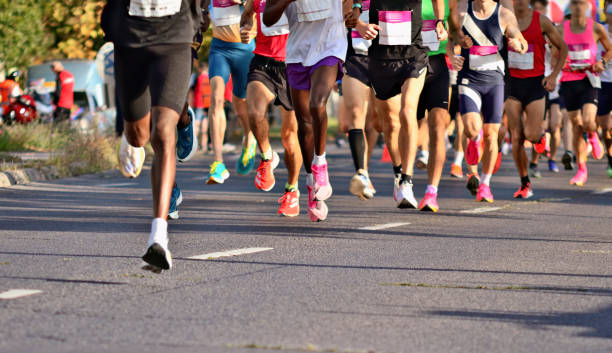A Training Pace Calculator is a tool that helps you figure out how fast or slow you should be performing during your workouts or races.
Our calculator gives you personalized run, bike, and swim paces based on your recent race times and distances.
Keep on reading to learn how to use our training calculator. We will also provide useful insights into types of training paces and how you can level up yours.
Our pace calculator is a simple and intuitive tool that will help you evaluate your running, swimming, and biking pace. Here's how to use it:
The calculator will generate personalized paces based on your race time and chosen training type.
Use these pace results as a guide during your workouts to maintain the right intensity and improve your performance.
You will want to monitor your progress regularly and adjust your paces as you continue training and improving. Now, let's delve into the types of training paces and what they mean.
How fast should we be going through your runs?
Let’s explore the different types of training paces that runners commonly use to optimize their workouts:
These runs are essential for building aerobic fitness and overall endurance.
How do you know if you're running at an easy pace? Basically, you run at a comfortable pace where you can easily hold a conversation.
Typically, 15-25% of your weekly training volume should be at an easy run pace. It is a fundamental part of marathon training or preparing for your triathlon race.
Tempo runs are performed at a comfortably hard pace, just below your lactate threshold. This pace is something you can hold for about an hour.
For many runners, tempo pace can be something between their 10k pace and half marathon pace.
Tempo runs improve your ability to sustain faster paces during longer efforts.
You want to include tempo runs into your workout routine once in every two to three weeks.
VO2 Max Runs
These are interval workouts designed to push your cardiovascular system to its limit. These runs are an essential component of training for runners aiming to improve their cardiovascular fitness and overall performance.
VO2 max is a measurement of how efficiently your body utilizes oxygen during intense exercise.
It represents the maximum amount of oxygen you can consume per kilogram of body weight in one minute (measured in milliliters per kilogram per minute, mL/kg/min).
Higher VO2 max values indicate better cardiovascular fitness and endurance.
Intervals
These are speed workouts that involve short bursts of fast running followed by recovery periods.
This type of training improves speed, power, and anaerobic capacity.
Examples include strides, hill sprints, and track intervals.
Long Runs
The long run is a slower pace suited for longer distances, usually slower than your race pace. Long runs build endurance and mental toughness for races.
Typically done at an easy pace, but the focus is on covering longer distances.
It is ideal for preparing for races like half marathons, marathons, and triathlons.

Incorporating a variety of paces into your training plan helps you become a well-rounded runner. You can always adjust these paces based on your muscular and skeletal strength, goals, and individual preferences.
Calculating your training pace is important for several reasons. Let's break them down.
Knowing your training pace helps you maintain the right intensity during workouts.
Training at the appropriate pace ensures you're challenging yourself enough to see improvements without overexerting or undertraining.
Understanding your pace allows you to set realistic training goals. When you know your current pace, you can establish achievable targets for race times, distances, and training milestones.
Let's say you're training for a half-marathon. You've been consistently running for a few weeks and have been tracking your pace during your training runs.
After analyzing your pace data, you determine that your average pace for a 5-kilometer (5K) run is around 6 minutes per kilometer.
Based on your current pace, you estimate that you can complete a half-marathon distance (21.1 kilometers) in approximately 2 hours and 7 minutes (6 minutes per kilometer x 21.1 kilometers). Therefore, you might aim to finish the half-marathon in under 2 hours and 15 minutes, allowing some buffer time.
Knowing your pace, you can plan your training runs accordingly. For example, you might aim to gradually increase your long run distance each week, ensuring that you maintain a pace that aligns with your overall race time goal.
Finally, you can establish milestones to track your progress leading up to the race. For instance, you might set a milestone to complete a 10K training run at your goal half-marathon pace within a certain timeframe. This helps measure your readiness and adjust your training as needed.
Training at the wrong pace can lead to overtraining, fatigue, and injury.
Calculating your training pace helps you avoid these risks by ensuring your workouts are appropriately challenging and balanced. Your training plan should include both hard sessions and easy recovery runs.
Tracking your training pace over time allows you to manage your progress and see improvements. Comparing your current pace to previous performances helps you improve your fitness level and adjust your training plan accordingly.
Training too fast too often can lead to burnout or injury. Calculating your race pace helps you find the balance between pushing yourself and avoiding overtraining.
So, after you've calculated your training pace and see that there's room for improvement, what do you do next?
You adapt your training plan according to your goals and keep training. We've got a few tips to help you level up your workout pace results.

There is no need to reinvent the wheel here. You can get better with your training pace when following these guidelines:
Our Training Pace Calculator is your go-to tool for evaluating your training pace.
It provides personalized paces based on your race times. Calculating your pace helps set realistic goals, track progress, and prevent overtraining.
With these insights and tips, you'll improve your performance and reach your goals in a desired timeframe.
You input your recent race time and choose your training type, and the calculator generates personalized paces for your training sessions.
You then use these paces to guide your workouts to maintain the right intensity and improve your performance.
The training pace calculator supports various types of training, runs, swimming sessions, and biking. Each training type requires different paces to achieve specific goals, such as building endurance, improving speed, or increasing lactate threshold pace.
Select the appropriate training type to ensure that the calculator provides you with the most relevant paces for your workouts.
A good running pace is one that feels comfortable and allows you to finish your run without feeling too tired. It's different for everyone depending on factors like fitness level and goals.
The most important thing is to listen to your body and find a pace that works for you.